Public Logistics: Helsinki South Harbor, Finland
Urban Design Competition
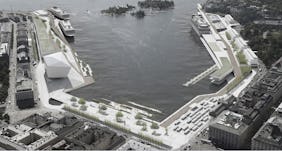
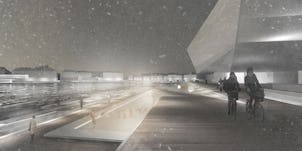
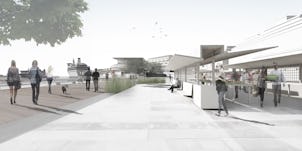
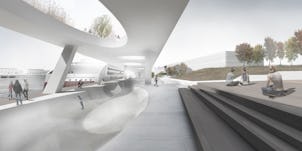
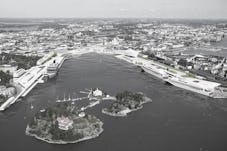
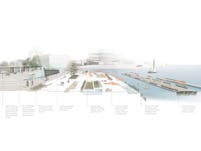
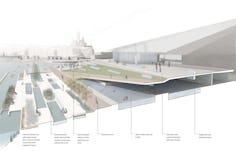
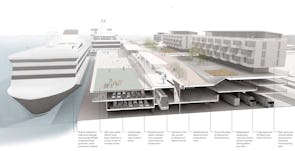
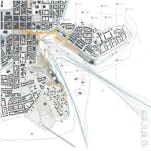
Across the developed world, cities are facing the conflict of activities that saturate and threaten the possibility of public space associated with waterfront development. For Helsinki’s South Harbour, we propose an approach that utilizes interlaced sectional landscapes to layer competing interests, improve performance, and prioritize the emergence of new social and cultural potentials combined with logistic, energy and ecological strategies to recover the space of the harbour for hybrid cultural and environmental uses.
Helsinki’s South Harbour is currently a complex matrix of civic and public space, market activity, urban infrastructure, harbour logistics, and marine ecologies, all competing for the same urban space. Can the South Harbour be both 100% Public and 100% Performance at the same time? We propose six strategies that bring these competing pressures into balance to create the new plan for Helsinki’s South Harbour and transform it into the premiere public space, identity and gateway for the city.
Several significant new cultural buildings will be located along the water’s edge. These are the rebuilt Makasiini Terminal and Marina Congress Centre on the Katanajokka side, the new Naval Museum and Archive at south Laivasilankatu, and the new Helsinki House of Art and Culture which will be lifted above grade allowing for public access, especially on its sloped sunny, southwest plaza which can be used for concerts and events. Below it will be the new indoor/outdoor Public Baths with year round heated pools and saunas that intersect with the public space creating a uniquely local cultural experience.
The space in front of the 19th century Kauppahalli is reconfigured so that the open-air market activities of the Kuppatori can take place adjacent to the market hall. The water’s edge is reworked to provide public waterfront access, private vessel docking, and the relocated historic Suomenlinna ferry terminal. This terrain is structured as a flexible infrastructural ground, complete with serviced market stalls where the constant daily hustle and bustle of the market and close contact with small water-craft will provide constant interest and activity.
The full length of the South Harbour waterfront is rendered as a contiguous space of public access. This is achieved by creating a deck of public surfaces that floats above the levels of logistics, parking and ferry access. The entire length of the harbour is connected with a new looped light rail tram line and the harbour perimeter can now be accessed by pedestrians from all sides of the surrounding city. The public space is animated with walking paths, bicycle routes, recreational fields, skate parks and is perforated with accessible heated pools and recreational water bodies for the pleasure of Helsinki’s citizens and visitors. Public, cultural, mixed-use buildings and housing define the perimeter street edge of the South Harbour ensure that the adjacent streets are walkable, animated and that there is a continuous community presence along the harbour.
Since the first urban plan in 1815, the Esplanade has been the most recognizable space of Helsinki’s city structure. This proposal shifts the Market Square out of the alignment with the Esplanade, and continues the grand boulevard directly to the waterfront where it folds down to become a public beach and forecourt to the proposed Helsinki House of Art and Culture at its terminus. A linear roofed pavilion housing tourist information, small shops, bars and restaurants defines the street edge and forms a threshold to Pohjoisesplanadi. Trees, shade umbrellas and benches provide places to gather, relax and watch the activity of the Harbour as well as a staging space for public events. Vitrines containing exhibits from the Marine Museum celebrate Helsinki’s heritage of boat-building and distribute cultural content across the public space. Shallow reflecting pools of water and an imported sand beach facilitate intimate and visceral contact with the water’s edge.
The Helsinki South Harbour will be integrated with advanced ecological approaches for biological waterfront remediation. Floating islands of wetland and bioreactive plant species help remove pollutants from the water. Along the perimeter and below the level of the boat hulls, an artificial ‘reef’ will be created that will support marine plants and species intended to restore the marine ecology of the site. Ferry effluent will be collected and converted to electricity and thermal energy onsite using innovative waste conversion technologies to provide energy to the public amenities. Heat exchangers will use the sea-water to efficiently heat the new buildings and structures. On land, stretches of local landscapes, trees and green roofs on the larger buildings will contain surface runoff and provide a habitat for local fauna.
Ferry traffic, parking and logistics are reworked so that vehicular activity is removed from the central waterfront and consolidated along the Katajanokka and Laivasilankatu sides. Partially covered by the continuous surfaces of public program, all storage, staging and escort traffic now moves freely and efficiently without defining the character of the harbour or impeding public access to the water’s edge.
| Typology | Urban Design Competition |
| date | 2011 |
| location | Helsinki, Finland |
| scale | 57 Acres |
| scope | Redevelopment of Helsinki’s South Harbor to redefine the image of the city while interlacing complex public, circulation, logistical and ecological demands. |
Team
| Project Team | Velikov Partner with Geoffrey Thün (rvtr). Team: Zain Abuseir, Din Blankenship, Mary O’Malley, Lisa Sauvé, Lauren Shirley, Adam Smith |